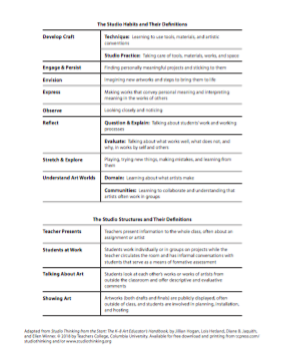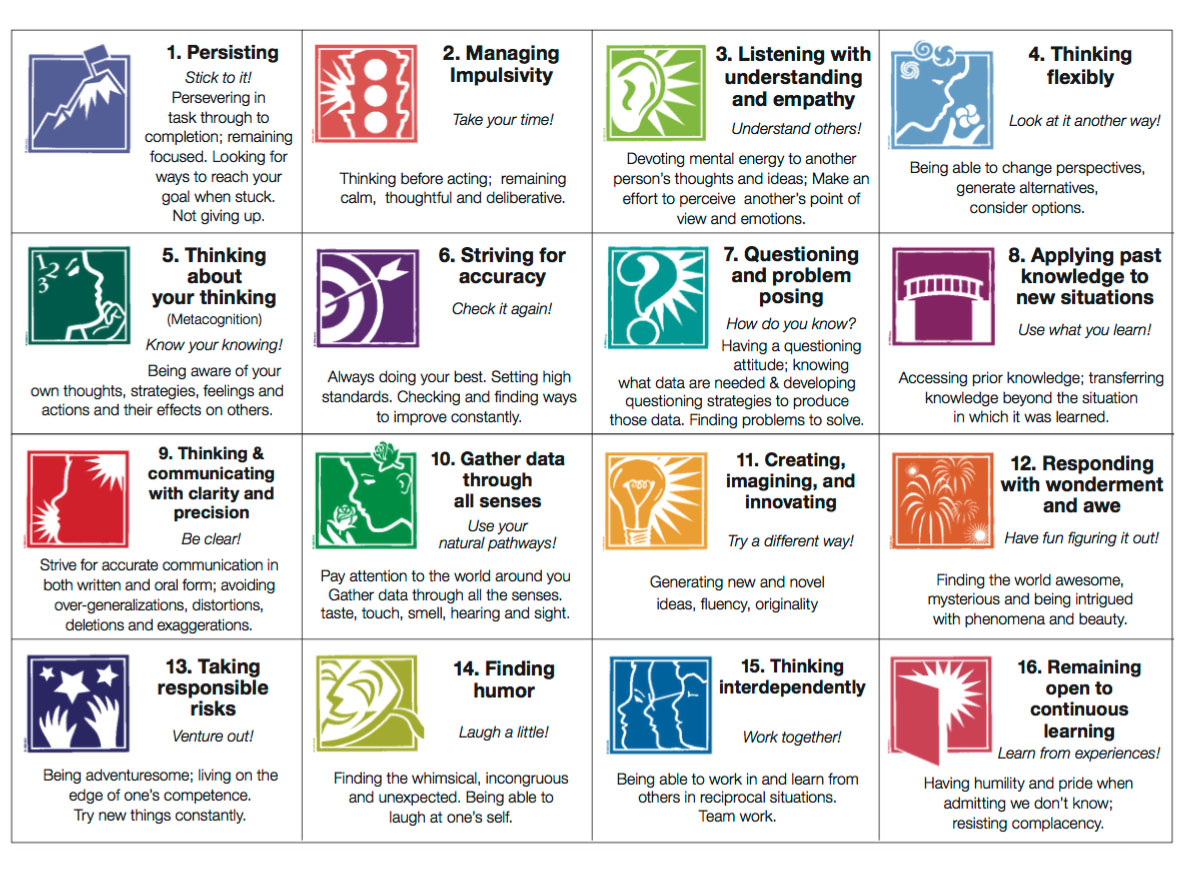
Learning to think and talk with others about an aspect of one’s work or working process, and learning to judge one’s own work and working process and the work of others. Learning to attend to visual contexts more closely than ordinary “looking” requires, and thereby to see things that otherwise might not be seen. Learning to create works that convey an idea, a feeling, or a personal meaning. Learning to picture mentally what cannot be directly observed, and imagine possible next steps in making a piece. Learning to embrace problems of relevance and personal importance, to develop focus conducive to working and persevering at tasks. Learning to use tools, materials, artistic conventions and learning to care for tools, materials, and space. The skills highlighted in the Habits transfer easily to situations outside the art room as they are adaptable to any learning situation. As students create in our Open Studio format, they are naturally absorbing and practicing these 21st Century skills. Students also had reference pages at their tables with the different types of lines on them.At Art With Susan, we look to the SHoM, identified by Harvard's Project Zero, to inform our best practices in the art room.

I continued the rotation so that each student had about 3-4 turns and then I gave the next direction. Students had to start their line where the last person left off and try to fill the entire page without overlapping. When the next group member was ready, I began the music again. When I stopped the music, the first person stopped. Then I played a song from the Broken Flowers soundtrack and the first student in the group began to draw. As one student put it, “compromise means you take part of what one person wants and part of what the other person wants and put it together.” Once I felt students understood the rules of this drawing “game,” I split them into small groups and each child got a pencil. We talked about some of the skills we would be practicing–like collaboration, compromise and cooperation.
#Stretch and explore studio habits of mind how to
To do this, students needed to take turns drawing lines, so we practiced how to do this on the rug first.

For the first lesson of this unit, I taught students different types of lines (straight, thick, thin, wavy, etc.) First I said the name of the line and drew it in the air with a “paintbrush” (my finger) as students repeated the words and gesture after me.Īfter learning each line, I told students that they would be creating a BIG drawing together. Kindergartners started a line unit a few weeks ago. Students notice many textures in nature including rough rocks, the smooth water, gritty sand, spiky pine needles and paint, pencils, spray paint, water, squeegees, and pastels as some of Heather’s drawing and painting tools and materials. The video shows Heather drawing and painting in various locations–near streams, in the woods, in her car and in her home studio.īefore the video I ask students to notice the various textures they see and drawing materials Heather uses when she works. The following class, I introduced students to contemporary artist Heather Day by watching a short video of her called On a River. I have taught this lesson many times and after class students often tell me that its one of the most fun art lessons they’ve done. The songs I play include jazz music, classical music, techno and blue grass.Īs the song play, I asked questions like, “What instrument do you hear? What color does this instrument sound like? Is this song fast or slow? How might you move your brush to match the speed of the song? What types of lines could you use to describe this sound?” Then I start playing music and students are challenged to describe the sounds they hear using paint.

Each pair of students get: a tray of paint, a mixing tray, a water cup, brushes, and a sponge to clean their brushes. Next, students gather their materials with a partner. After reading The Noisy Paintbox, students walk to their tables and I demonstrat how to fold the paper into 4 equal boxes. The biography tells the story Vasily Kandinsky, a Russian artist who studied in Europe and is one of the founders of Western abstraction.īefore students arrived, I had placed a blank 9 x 12 inch piece of paper at their table spots. I began this unit by reading The Noisy Paintbox, by Barb Rosenstock.


 0 kommentar(er)
0 kommentar(er)
